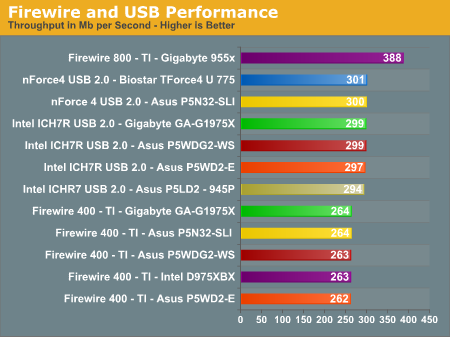NVIDIA nForce4 Ultra: Biostar's Performance Surprise
by Gary Key on February 16, 2006 12:05 AM EST- Posted in
- Motherboards
Firewire and USB Performance
After looking at many options for Firewire and USB testing, we finally determined that an external USB 2.0, Firewire 400, and Firewire 800 hard disk would be a sensible way to look at USB and Firewire throughput.
Our first efforts at testing with an IDE or SATA drive as the "server" yielded very inconsistent results, since Windows XP sets up cache schemes to improve performance. Finally, we decided to try a RAM disk as our "server", since memory removed almost all overhead from the serving end. We also managed to turn off disk caching on the USB and Firewire side by setting up the drives for "quick disconnect" and our results were then consistent over many test runs.
We used 1GB of fast 3-2-2-8 system memory set up as a 450MB RAM disk and 550MB of system memory. Our standard file is the SPECviewPerf install file, which measures 432,533,504 bytes (412.4961MB). After copying this file to our RAM disk, we measured the time for writing from the RAM disk to our external USB 2.0, Firewire 400, or Firewire 800 drive using a Windows timing program written for AnandTech by our own Jason Clark. The copy times in seconds were then converted into Megabits per second (Mb) to provide a convenient means of comparing throughput. Higher Rates therefore mean better performance in this particular test.
The Biostar TForce4 U 775 board does not offer a Firewire option. The USB 2.0 performance is consistent with other NVIDIA based boards and continues to lead the Intel chipset solutions in throughput.
After looking at many options for Firewire and USB testing, we finally determined that an external USB 2.0, Firewire 400, and Firewire 800 hard disk would be a sensible way to look at USB and Firewire throughput.
Our first efforts at testing with an IDE or SATA drive as the "server" yielded very inconsistent results, since Windows XP sets up cache schemes to improve performance. Finally, we decided to try a RAM disk as our "server", since memory removed almost all overhead from the serving end. We also managed to turn off disk caching on the USB and Firewire side by setting up the drives for "quick disconnect" and our results were then consistent over many test runs.
We used 1GB of fast 3-2-2-8 system memory set up as a 450MB RAM disk and 550MB of system memory. Our standard file is the SPECviewPerf install file, which measures 432,533,504 bytes (412.4961MB). After copying this file to our RAM disk, we measured the time for writing from the RAM disk to our external USB 2.0, Firewire 400, or Firewire 800 drive using a Windows timing program written for AnandTech by our own Jason Clark. The copy times in seconds were then converted into Megabits per second (Mb) to provide a convenient means of comparing throughput. Higher Rates therefore mean better performance in this particular test.

The Biostar TForce4 U 775 board does not offer a Firewire option. The USB 2.0 performance is consistent with other NVIDIA based boards and continues to lead the Intel chipset solutions in throughput.










31 Comments
View All Comments
Zoomer - Monday, September 18, 2006 - link
I was really interested in buying this board to replace a dead board until I read the part about ALC 850. Urgh.The 10/100 ethernet was also an issue, but I could have lived with that. But no HD Audio? This is 2006, not 1996.
neweggster - Wednesday, February 22, 2006 - link
I would like to see more articles from Biostar. They seem to have a good idea on what performance is. Any idea if you guys could get a article on the Biostar TForce4U Socket 939 NVIDIA nForce4 Ultra AMD mobo?Gary Key - Wednesday, February 22, 2006 - link
We are working on it. :)cpeter38 - Tuesday, February 21, 2006 - link
How come AT has taken down the RS580 article (at least) twice now??Gary Key - Tuesday, February 21, 2006 - link
The NDA for the RD580 is on 3/2/06. ATI has requested the review sites adhere to this date. However, if you look around the net the article has been saved in a zip file and is available for viewing. ;-)
cpeter38 - Tuesday, February 21, 2006 - link
THANK YOU!!!!(for the explanation)
cpeter38 - Tuesday, February 21, 2006 - link
ACCCHHH!!********** EDIT *************** EDIT ************
RD580!!!
ronein - Sunday, February 19, 2006 - link
I second that!
lexmark - Friday, February 17, 2006 - link
Very detailed and coherent article! I am in no way in the market for an intel/biostar board (how many are? ;), but the review was a pleasure to read. I found the author's writing style to be very unique and the article overall was outstanding. Keep up the good work AT!bldckstark - Thursday, February 16, 2006 - link
Good job on including the min and max frame rates on the graphs. That is an excellent addition. Now if we can just get the median and mode......... *>}